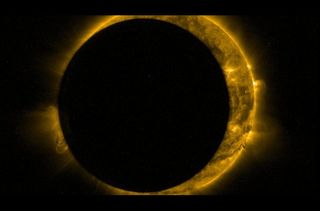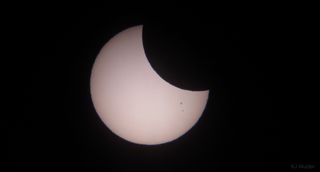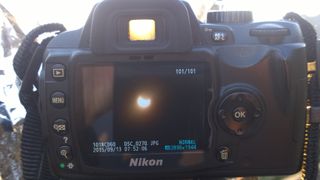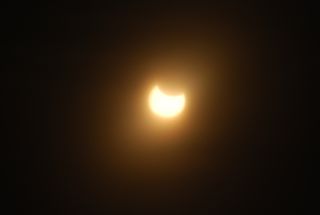Partial Solar Eclipse 2015: See Photos from Space, Skywatchers

When the moon blocked the sun in a partial solar eclipse on Sunday (Sept. 13) a European satellite managed to catch the celestial event on camera not once but three different times. Meanwhile, back on Earth, viewers in South Africa saw it just once, but were still able to enjoy the view.
The European Space Agency's (ESA) satellite Proba-2, which focuses on the sun, captured three times as much eclipse as Earth did by dodging in and out of the moon's shadow as it orbited the planet. In each pass through the moon's shadow, the satellite caught the dark sphere of the moon covering part of the sun, acquiring a thick, fiery solar halo in the satellite's extreme ultraviolet SWAP imager. At Space.com, we assembled Proba-2's view of the solar eclipse in a gallery alongside other images by skywatchers on Earth.
Skywatchers in South Africa, meanwhile, set up early and dodged hazy clouds to view and document the moon's approach. The eclipse was also visible from the southern Indian Ocean and Antarctica.
"I didn't have much hope of observing the eclipse, since the previous evening was cloudy and more cloudy weather was predicted for this morning," said K.J. Mulder, a blogger and space photographer based in Western Cape, South Africa. "I was pleased to find hazy, high level clouds in the sky when I woke up. While not ideal, it would at least allow me to observe the eclipse in some form," Mulder said in an email to Space.com. [Solar Eclipses: An Observer's Guide (Infographic)]

Mulder captured the eclipse with a 3.5-inch Skywatcher refractor telescope equipped with a Baader solar filter and, along with his sister, viewed the eclipse with eclipse glasses. "Without the eclipse glasses, you couldn't really tell that the eclipse was happening, aside from a slight dimming to the normal light conditions," he said. "Through the eclipse glasses, the eclipse was clearly visible to the naked eye, with the sun appearing distinctly Pac-Man-like." Mulder was also able to glimpse two sunspots on the solar surface.

Zarina Ebrahim, a graphic designer in Cape Town, South Africa, kept an eye on the eclipse from the foot of Cape Town's Table Mountain. She used a Nikon D60 camera with a Mylar filter, Ebrahim told Space.com in an email.

Her friend Rudolph used Mylar filter glasses to look at the eclipse as well; the camera setup is visible in the background of the photo. Prepared skywatchers in the right location could catch the eclipse in progress — if only once as compared to Proba-2's three times.
Get the Space.com Newsletter
Breaking space news, the latest updates on rocket launches, skywatching events and more!

Sunday, Sept. 27 will bring another spectacular sight: Observers throughout the Americas, Europe, Africa, western Asia and the eastern Pacific Ocean region will be able to see a "supermoon" lunar eclipse, when an extra-bright and large full moon will be blotted out by the Earth's shadow — the first such eclipse since 1982. A similar event will not occur again until 2033, so be sure to look up.
Email Sarah Lewin at slewin@space.com or follow her @SarahExplains. Follow us @Spacedotcom, Facebook and Google+. Original article on Space.com.
Join our Space Forums to keep talking space on the latest missions, night sky and more! And if you have a news tip, correction or comment, let us know at: community@space.com.

Sarah Lewin started writing for Space.com in June of 2015 as a Staff Writer and became Associate Editor in 2019 . Her work has been featured by Scientific American, IEEE Spectrum, Quanta Magazine, Wired, The Scientist, Science Friday and WGBH's Inside NOVA. Sarah has an MA from NYU's Science, Health and Environmental Reporting Program and an AB in mathematics from Brown University. When not writing, reading or thinking about space, Sarah enjoys musical theatre and mathematical papercraft. She is currently Assistant News Editor at Scientific American. You can follow her on Twitter @SarahExplains.
